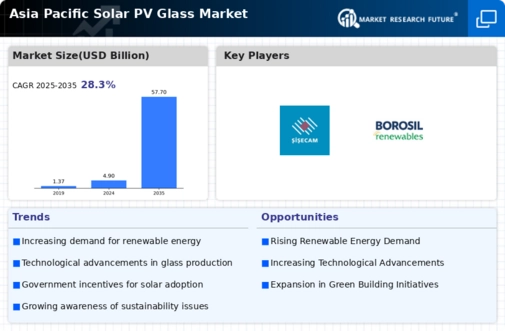Asia Pacific Solar PV Glass Market Summary
The Asia-Pacific Solar PV Glass market is projected to experience substantial growth, reaching 94.99 USD Billion by 2035 from a base value of 6.12 USD Billion in 2024.
Key Market Trends & Highlights
Asia Pacific Solar PV Glass Key Trends and Highlights
- The market is expected to grow from 4.9 USD Billion in 2024 to 57.7 USD Billion by 2035.
- The compound annual growth rate (CAGR) for the period from 2025 to 2035 is estimated at 25.12%.
- This growth trajectory indicates a robust expansion in the adoption of solar technologies across the region.
- Growing adoption of solar energy solutions due to increasing environmental awareness is a major market driver.
Market Size & Forecast
| 2024 Market Size | 6.12 (USD Billion) |
| 2035 Market Size | 94.99 (USD Billion) |
| CAGR (2025-2035) | 28.30% |
Major Players
Nippon Sheet Glass Co Ltd., AGC Inc., KANEKA CORPORATION, Sisecam, Xinyi Solar Holdings Limited, Taiwan Glass Ind. Corp., Flat Glass Group Co. Ltd., Borosil Renewables Ltd., IRICO Group New Energy Co Ltd., Onyx Solar Group LLC













Leave a Comment